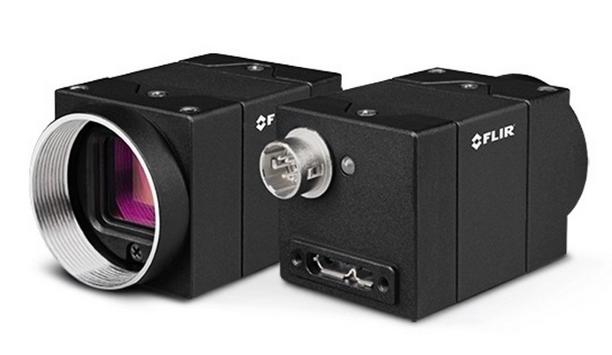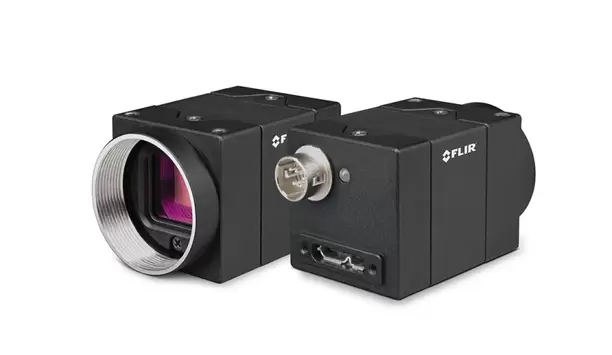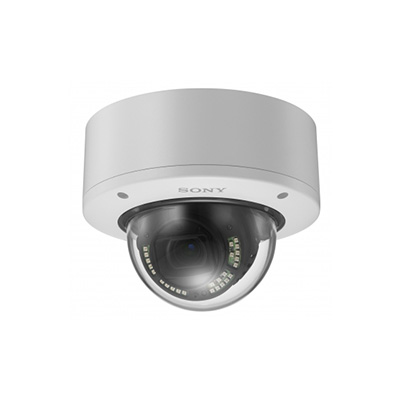Sony Professional Solutions Europe - Experts & Thought Leaders
White papers from Sony Professional Solutions Europe
Preventing retail losses with intelligent HD surveillance
DownloadHarness the power of Full HD picture quality
DownloadClearer security images with View-DR
DownloadDefining a strategy for migrating from analogue to IP
DownloadHow to migrate to IP surveillance from analogue: Strategies & Tips
DownloadCasino surveillance in revolutionary HD
DownloadLatest Sony Professional Solutions Europe news & announcements
Introducing the latest additions to the Teledyne FLIR Blackfly S UB3 camera line – the BFS-U3-50S4M-C and BFS-U3-50S4C-C. These 5 MP models are particularly well suited for integration into small handheld devices with their impressive low weight of 53 grams and high pixel density ideal for integrating with compact, less expensive lenses. Leveraging Sony’s IMX547 sensor, they deliver exceptional low-light performance with superior quantum efficiency and very low absolute sensitivity making them suitable for a range of challenging applications from biometrics to scientific research and more. Superior quantum efficiency Read along for more detailed specs, pricing and to consult a specialist about the project requirements. 5 MP 2448 x 2048 @ 72 FPS global shutter CMOS. At 53 grams, the lightest weight camera with IMX547. High QE and low noise yield a low Absolute Sensitivity Threshold (4.4 photon AST). Superior quantum efficiency (68% QE @ 525nm). Excellent low-light performance (2.53 e- read noise). Small pixel size enables less expensive, more compact optics. High sensitivity (High QE and Low AST) reduces lighting system requirements.
FLIR Systems, Inc. announced the availability of the new FLIR Blackfly S visible spectrum camera module, the first to integrate the Sony Pregius S IMX540 sensor with 24.5 MP at 12 FPS in a USB3 camera. The combination of the Blackfly S feature set with IMX540’s high megapixel (MP) count and fast imaging enables engineers and researchers from biomedical to semiconductor industries to inspect more in less time and with fewer cameras required. Machine vision expertise OEM machine designers, and researchers rely on FLIR for high quality, full-feature machine vision cameras" “OEM machine designers, engineers and researchers rely on FLIR for high quality, full-feature machine vision cameras,” said Paul Clayton, General Manager, Components Business at FLIR Systems. “With this latest Blackfly S model, we continue the tradition of combining the best technology with world-class support to empower our customers to achieve their objectives faster and at lower costs.” With a new backside illuminated (BSI) 2.74 µm pixel, the Pregius S sensors nearly doubles the pixel density of earlier Pregius sensors while taking advantage of lower cost and more compact lenses. Delivering 24 MP, 12 FPS Sony Pregius distortion-free imaging of fast-moving targets, the Blackfly S enables faster production lines even for very detailed inspection. High quantum efficiency The Blackfly S also delivers high quantum efficiency and low read noise allowing shorter exposure times, and therefore less powerful lights are required resulting in lower lighting costs. The FLIR Blackfly S BFS-U3-244S8M/C-C is available for purchase globally through FLIR and authorised FLIR distributors. FLIR will also release additional Pregius S sensors on GigE and 10GigE interfaces later this year. To learn more about the Sony Pregius S, visit the company’s official website.
With the continued demand for IP Video Surveillance in Small and Medium-scale Enterprises, new solutions that produce better image quality in the most challenging conditions are needed. To meet the growing needs of SMBs, Matrix has strengthened its offerings by adding 5MP IP Cameras to its existing range of 2MP and 3MP IP Cameras. Equipped with Sony STARVIS sensor with Exmor technology the 5MP IP Camera delivers a true, 104-degree Horizontal field-of-view (FOV) and exceptional low light performance in light as low as 0.01 lux. With its H.265 compression, users can reduce storage consumption by up to 30%. Available in Dome and Bullet variants, Matrix 5MP IP Cameras are ideal for both indoor and outdoor applications. Exceptional quality low light images Key Features: Better Quality Images with 5 MP Resolution Sony Starvis series Sensor with Exmor Technology for Exceptional Low Light Performance Larger Field-of-View (FOV) – 104 degrees HFOV Colour Images in Light as Low as 0.01 lux IP67 and IK10 Protection Latest H.265 Compression Technology True WDR – to Deliver Consistent Images in Varying Light Conditions “Higher resolution and detailed images enable 24*7 effective surveillance. Matrix’s existing range delivers exceptional quality low light images, and the new 5MP resolution takes it to a completely new level. Owing to the high resolution, these IP cameras provide sharper and brighter images with even more details.” said Vihar Soni, Marketing Manager, Matrix Comsec.
Insights & Opinions from thought leaders at Sony Professional Solutions Europe
For the security market, the ‘fine ranging’ capabilities of ultra-wideband (UWB) technology opens up a range of new uses based on the ability to determine the relative position and distance of two UWB-equipped devices with pinpoint accuracy – within centimetres. UWB is more accurate and secure, even in challenging environments full of interference, compared to narrow band wireless technologies. UWB technology transmits a large amount of data over short distances using a small amount of energy. It will be used in seamless access control, location-based services, and device-to-device services across industries including smart homes, cities, retail services, and healthcare. Increasing the accuracy of ranging measurements UWB technology will support any application that benefits from knowing the precise location of a connected deviceUltra-wideband is a mature radio technology that transmits information spread over a large bandwidth, as described by the IEEE 802.154 standard. A new, enhanced amendment to the standard – IEEE 802.15.4z – focusses on improvements to existing modulations to increase the integrity and accuracy of ranging measurements. Moving forward, UWB technology will support any application that benefits from knowing the precise location or presence of a connected device or object. This reflects a move from data communication to secure sensing. New capabilities of UWB are largely unfamiliar to the market, but a new Consortium – the FiRa Consortium – has a mission to educate the market, provide use cases, and promote UWB technology. Delivering interoperability across devices “With a consortium, we can better deliver interoperability across devices, software, and chipsets,” says Ramesh Songukrishnasamy, Director and Treasurer of the FiRa Consortium, and SVP & CTO of HID Global. “This creates a frictionless experience for the user, which is vitally important with a new technology. People are more likely to adopt emerging technology when it runs smoothly without interruptions or errors.” The FiRa consortium is ensuring new use cases for fine ranging capabilities can thrive" An industry consortium can create a UWB ecosystem of interoperable technologies instead of individual companies launching products that consumers struggle to make work together, says Songukrishnasamy. “Simply, the FiRa consortium is ensuring new use cases for fine ranging capabilities can thrive.” Founding members of the FiRa consortium ASSA ABLOY and HID Global, pioneers in secure access and identity solutions, are founding members of the consortium. Their technology manages access to physical and digital places, things, and identities. Another founding consortium member, NXP Semiconductors, is a pioneer in secure connectivity solutions for embedded applications. Other founding members are Samsung, which creates top-of-the-line TVs, smartphones, wearables, and other connected devices; and the Bosch Group, a global supplier of technology and services that is at the forefront of IoT innovations. Sony Imaging Products & Solutions Inc., LitePoint and the Telecommunications Technology Association (TTA) are the first companies to join the newly formed organisation. Immune to radio frequency interference UWB is also immune to radio frequency interference, so it functions in high traffic settingsUWB introduces higher levels of accuracy in positioning capabilities and increased security for ranging data exchange compared to existing technologies. Fine ranging with UWB technology can localise devices and objects to 10 centimetres of accuracy with or without line of sight. UWB is also immune to radio frequency interference, so it functions in high traffic settings. These capabilities will enable a variety of use cases like secure, hands-free access control in hospitals, location-based services for ride sharing, and targeted marketing for retailers. FiRa will demonstrate UWB technology at upcoming trade shows. The FiRa Consortium aims to build on IEEE’s work with an interoperable high rate physical layer (HRP) standard, including defining an application layer that discovers UWB devices and services and configures them in an interoperable manner. The consortium also plans to develop service-specific protocols for multiple verticals and define necessary parameters for applications including physical access control, location-based services and device-to-device services. Promoting the adoption of UWB solutions As a consortium, FiRa is not just setting standards but actively championing use cases for UWB technology. Creating the consortium addresses the need to develop interoperability and implementation standards; brings key players together to create a rich UWB ecosystem; allows for the sharing of intellectual property; and promotes the adoption of UWB solutions. The FiRa Consortium is committed to educating and promoting new use cases" “Since UWB is a mature technology with new potential uses, there is a general lack of awareness of potential applications that take advantage of the technology,” says Songukrishnasamy. “The FiRa Consortium is committed to educating and promoting new use cases.” The FiRa name comes from Fine Ranging to highlight UWB technology’s use cases and distinction from older UWB technologies and solutions. Enhanced security in challenging environments Fine ranging powered by UWB can outperform other technologies in terms of accuracy, power consumption, robustness in wireless connectivity, and security, especially in challenging, high density environments. UWB previously served as a technology for high data rate communication and as such was in direct competition with Wi-Fi. Since then, UWB has undergone several transformations: UWB has evolved from an OFDM-based data communication to an impulse radio technology specified in IEEE 802.15.4a (2ns pulses with Time of Flight); and A security extension being specified in IEEE 802.15.4z (at PHY/MAC level) makes it a unique secure fine ranging technology. Moving from data communication to secure ranging allows ‘spatial context capability’ to be utilised by a variety of applications: seamless access control, location-based services, and device-to-device (peer-to-peer) services. Information is available at firaconsortium.org.
Again in 2016, the most well-trafficked articles posted at SourceSecurity.com tended to be those that addressed timely and important issues in the security marketplace. In the world of digital publishing, it’s easy to know what content resonates with the market: Our readers tell us with their actions; i.e., where they click. Let’s look back at the Top 10 articles we posted in 2016 that generated the most page views. They are listed in order here with the author’s name and a brief excerpt. 1. Why Hikvision is suddenly front-page news: The company responds to security concerns [Ron Alalouff] It is perhaps [Hikvision’s] spectacular growth that has fueled some of the claims and concerns about the company, most recently in the UK in a front-page article in The Times. While highlighting the company’s success – in the UK it has sold more than a million cameras and recorders installed at sites such as government buildings, airports and sports stadiums – the article questioned whether there is sufficient oversight of the security implications of foreign involvement in critical infrastructure. 2. Tyco and Johnson Controls merger driven by convergence of security with smart building technology [Larry Anderson] This week, Johnson Controls and Tyco have announced their merger into one company with annual revenue of $32 billion. The new Johnson Controls will be almost a direct reflection of one of the industry’s biggest trends – the move toward technology convergence and smart buildings. 3. Weaponised robots? Military and police response uses for robots on the rise [Randy Southerland] The era of the “killer robot” hasn’t arrived, exactly, but it may not be far off. Police and the military have been using these machines for decades now to disarm bombs and provide reconnaissance in areas where it would be risky to send officers or soldiers. Police and the military have been using these machines for decades now to disarm bombs and provide reconnaissance (Image credit: Antonio Scorza / Shutterstock.com) 4. Security industry speculates as Honeywell-UTC deal falls through [Larry Anderson] In a year of mega-deals impacting the security marketplace, one of the big news stories recently was a deal that did not happen – between giants Honeywell and United Technologies (UTC). Financial news pages have been full of the back-and-forth between these two companies. It seems Honeywell wanted to merge with UTC, but UTC declined because of “insurmountable regulatory obstacles and strong customer opposition.” So the deal is off, at least for now. 5. Home automation: A growth area for the security industry? [Ron Alalouff] Despite the market entry of some big names such as Google’s Nest, Apple’s HomeKit, and telecommunications giants AT&T and Deutsche Telekom, are we really on the threshold of a home automation revolution? Not quite, according to market intelligence firm Ovum. 6. Bosch-Sony partnership amounts to a new variation on M&A [Larry Anderson] Might there be more such partnerships to come as the number of companies serving the video surveillance market adjusts to its size? Might “softer” consolidation like the Bosch-Sony deal be the next big thing and even slow down the pace of mergers and acquisitions? Time will tell, but it’s clear the benefits of such an approach might be attractive to other companies, too. Bosch will handle the sales and marketing globally for all of Sony’s video surveillance products (outside of Japan) 7. Pelco by Schneider Electric CEO Sharad Shekhar to revive Pelco global video security business [Deborah O’Mara] Pelco has made significant investments in key vertical markets, including oil and gas, gaming and casinos, Safe Cities, and airports and seaports, and [the company] will see significant focus on product and business development in these markets. [Pelco] will look to further engage customers in these spaces by focusing not just on products, but on solutions that will solve security and operational challenges. 8. Deep learning technology applications for video surveillance [Paul Sun] Although deep learning has been applied to many industries with breakthrough results compared to legacy systems, not all applications are suitable for deep learning. In the field of video surveillance, several applications stand out that can benefit from deep learning. 9. Electronic locks prove a worthwhile investment for the security industry [Michael J. Mahon] Mechanical locks and keys date back thousands of years and have undergone many changes, but the industry’s transition to electronic locks might be the most important, lasting, and surprisingly affordable security and safety change of all. The objective behind the creation of locks so long ago remains: to control a value on the other side of a door. But the security industry as a whole is migrating from the perceived “cheaper” and historical mechanical lock to the newest technology of electronic locks. 10. Understanding starlight camera technology and low-light applications in the security industry [Alyssa Fann] Starlight cameras are the latest products security companies are adding to their product line-ups, each camera boasting the most comprehensive ability to make darkness visible. While low-light surveillance capabilities have been around on the market for some time, starlight camera technology is redefining low-light surveillance to new levels. See the full coverage of 2016/2017 Review and Forecast articles here Save Save
Merger and acquisition activity has become a familiar topic in the physical security market. In 2016, SourceSecurity.com covered M&A news involving some of the industry’s largest companies, including high-profile names such as Tyco, Honeywell, Hikvision, ADT, and Ingram Micro. Here’s a look at the top 10 M&A stories in 2016, as covered by SourceSecurity.com: 1. Johnson Control and Tyco merge Johnson Controls and Tyco announced their merger into one company with annual revenue of $32 billion. Johnson Controls, a global multi-industrial company, combined with global fire and security provider Tyco to create a leader in building products and technology, integrated solutions and energy solutions. Johnson Controls previously had a small presence in the physical security market, but their products have mostly centred around building controls, HVAC and energy storage technology. For its part, Tyco’s focus on video, access control and alarm systems has expanded to consider those systems in the context of broader building systems. The trend toward convergence in the building market is the common ground for these companies, and a major driver in their decision to merge under the name Johnson Controls. 2. Honeywell acquires Xtralis and RSI Video Technologies Industry giant Honeywell agreed to acquire Xtralis, a global provider of aspirating smoke detection and advanced perimeter security technologies and video analytics software, for $480 million from funds advised by Pacific Equity Partners and Blum Capital Partners. Honeywell saw Xtralis' systems as complementing their growing Security and Fire business. A month or so later, Honeywell also acquired RSI Video Technologies, provider of the Videofied Intrusion Detection System, for $123 million. Upon completion of the acquisitions, both would become part of Honeywell Security and Fire. Honeywell also made headlines for a deal that didn’t happen. It seems Honeywell wanted to merge with UTC, but UTC declined because of “insurmountable regulatory obstacles and strong customer opposition.” 3. Ingram Micro acquired by Chinese Conglomerate Ingram Micro Inc. and Tianjin Tianhai Investment Company, Ltd. announced a merger agreement under which Tianjin Tianhai would acquire Ingram Micro for $38.90 per share in an all-cash transaction with an equity value of approximately $6 billion. Ingram Micro would become a part of HNA Group, a Hainan-based Fortune Global 500 enterprise group and a leader in aviation, tourism and logistics and the largest stockholder of Tianjin Tianhai. ADT holds the largest share of the U.S. residential security market, and a respectable small business presence 4. ADT Merges with Protection 1 ADT, the well-known home and small business security company, which traces its history back to 1874, agreed in 2016 to be acquired by private equity firm Apollo Global Management, and would merge with competitor Protection 1, a subsidiary of Apollo-owned Prime Security Services Borrower LLC. The announcement comes amid rapid changes in the residential security and home automation market, much of it driven by emerging Internet of Things (IoT) technology. ADT holds the largest share of the U.S. residential security market, and a respectable small business presence. Protection 1 began in 1991 when it was spun off from PacifiCorp., a power utility. It grew rapidly, largely through acquisition, into a full-service business and home security company. 5. Konica Minolta acquires majority shares of MOBOTIX Konica Minolta, Inc. entered into a share transfer agreement to acquire shares comprising about 65% ownership of German manufacturer MOBOTIX, developer of technologies including decentralised processing (edge computing) IP cameras, image data compression, and image data analytics. The deal was estimated at between $177 million and $265 million. Konica Minolta seeks to broaden the distribution of MOBOTIX products and solution services by leveraging its global direct sales network and after-sales support and services systems. 6. Hikvision acquires Pyronix Hikvision, the world’s largest video surveillance manufacturer, announced the acquisition of Pyronix, the UK-based intrusion alarm security firm. Hikvision planned to apply Pyronix expertise and know-how in intrusion detection systems to its leading position in the video surveillance market. The combined know-how of Hikvision and Pyronix seeks to bring new advancements and innovative products to the market, converging two security technologies in video surveillance and intrusion detection. 7. Merger creates AlliedUniversal brand AlliedBarton Security Services and Universal Services of America agreed to merge, combining to do business under the AlliedUniversal brand. The combined company offers clients localised response and national support using technology solutions and approximately 140,000 highly-trained officers. The combined company is expected to have total annual revenues of approximately $4.5 billion. AlliedUniversal brand offers clients localised response and national support 8. Acre acquires two companies ACRE, LLC, the holding company that owns Vanderbilt Industries and Mercury Security, made two more acquisitions this year. Through its subsidiary Vanderbilt, a global provider of state-of-the-art security systems, Acre acquired Access Control Technology Ltd (ACT), based in Dublin, Ireland. This purchase would enhance Vanderbilt’s strategic expansion plans for strengthening its access control business and product portfolio. Later in the year, Acre also announced plans to acquire Communication Networks LLC (dba ComNet), a manufacturer of video and data transmission equipment. The acquisition of ComNet builds on the ACRE family of companies, providing complementary communication technologies utilised across its access control, intrusion, video, and cloud-based product ranges. 9. Gemalto to buy 3M’s identity business Gemalto, a provider of digital security, agreed to acquire 3M's Identity Management Business for US $850 million; it will become part of Gemalto Government Programs. 3M's Identity Management Business is comprised of 3M Cogent Inc., which provides a full spectrum of biometric solutions with a focus on civil identification, border control and law enforcement, and 3M's Document Reader and Secure Materials Businesses. 10. Bosch and Sony partner up Although technically not a merger or acquisition, Bosch Security Systems and Sony signed a contract to establish a business partnership to collaborate in the development of products and solutions in the field of video security applications, beginning in 2017. Bosch will handle the sales and marketing globally for all of Sony’s video surveillance products (outside of Japan). The two companies will also pool their technology expertise, leveraging Sony’s imaging capabilities and Bosch’s analytics and networking strengths. See the full coverage of 2016/2017 Review and Forecast articles hereSave Save Save
One system, one card
DownloadAligning physical and cyber defence for total protection
DownloadUnderstanding AI-powered video analytics
DownloadEnhancing physical access control using a self-service model
DownloadHow to implement a physical security strategy with privacy in mind
DownloadSony SNC-VM772R 4K IP security camera
Sony SNC-VM630 true day/night HD network mini dome camera with 700 TVL resolution






































